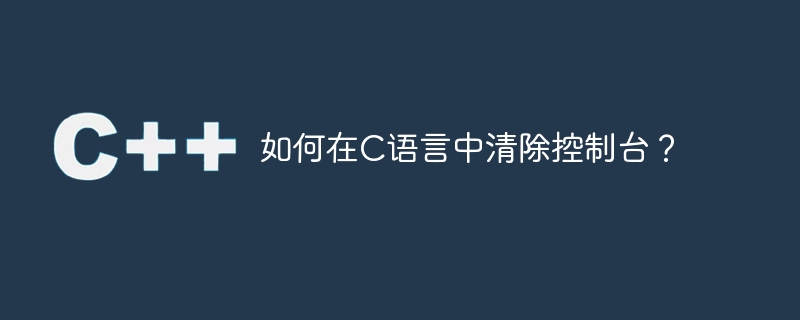How to clear console in C language?

There are several ways to clear the console or output screen, one of which is the clrscr() function. It clears the screen when the function is called. It is declared in the "conio.h" header file. There are some other methods such as system("cls") and system("clear"), which are declared in the "stdlib.h" header file.
The following is the syntax to clear the console in C language:
clrscr(); OR system(“cls”); OR system(“clear”);
The following is an example of clearing the console in C language:
Suppose we have a file called " new.txt" file with the following content:
0,hell!o 1,hello! 2,gfdtrhtrhrt 3,demo
Now, let us look at an example.
Example
#include<stdio.h>
#include<conio.h>
void main() {
FILE *f;
char s;
clrscr();
f=fopen("new.txt","r");
while((s=fgetc(f))!=EOF) {
printf("%c",s);
}
fclose(f);
getch();
}Output
0,hell!o 1,hello! 2,gfdtrhtrhrt 3,demo
clrscr();
f=fopen("new.txt","r");
while((s=fgetc(f))!=EOF) {
printf("%c",s);
}The above is the detailed content of How to clear console in C language?. For more information, please follow other related articles on the PHP Chinese website!

Hot AI Tools

Undresser.AI Undress
AI-powered app for creating realistic nude photos

AI Clothes Remover
Online AI tool for removing clothes from photos.

Undress AI Tool
Undress images for free

Clothoff.io
AI clothes remover

AI Hentai Generator
Generate AI Hentai for free.

Hot Article

Hot Tools

Notepad++7.3.1
Easy-to-use and free code editor

SublimeText3 Chinese version
Chinese version, very easy to use

Zend Studio 13.0.1
Powerful PHP integrated development environment

Dreamweaver CS6
Visual web development tools

SublimeText3 Mac version
God-level code editing software (SublimeText3)

Hot Topics
 How to handle special characters in C language
Apr 03, 2025 pm 03:18 PM
How to handle special characters in C language
Apr 03, 2025 pm 03:18 PM
In C language, special characters are processed through escape sequences, such as: \n represents line breaks. \t means tab character. Use escape sequences or character constants to represent special characters, such as char c = '\n'. Note that the backslash needs to be escaped twice. Different platforms and compilers may have different escape sequences, please consult the documentation.
 How to convert char in C language
Apr 03, 2025 pm 03:21 PM
How to convert char in C language
Apr 03, 2025 pm 03:21 PM
In C language, char type conversion can be directly converted to another type by: casting: using casting characters. Automatic type conversion: When one type of data can accommodate another type of value, the compiler automatically converts it.
 How to use char array in C language
Apr 03, 2025 pm 03:24 PM
How to use char array in C language
Apr 03, 2025 pm 03:24 PM
The char array stores character sequences in C language and is declared as char array_name[size]. The access element is passed through the subscript operator, and the element ends with the null terminator '\0', which represents the end point of the string. The C language provides a variety of string manipulation functions, such as strlen(), strcpy(), strcat() and strcmp().
 What is the role of char in C strings
Apr 03, 2025 pm 03:15 PM
What is the role of char in C strings
Apr 03, 2025 pm 03:15 PM
In C, the char type is used in strings: 1. Store a single character; 2. Use an array to represent a string and end with a null terminator; 3. Operate through a string operation function; 4. Read or output a string from the keyboard.
 Avoid errors caused by default in C switch statements
Apr 03, 2025 pm 03:45 PM
Avoid errors caused by default in C switch statements
Apr 03, 2025 pm 03:45 PM
A strategy to avoid errors caused by default in C switch statements: use enums instead of constants, limiting the value of the case statement to a valid member of the enum. Use fallthrough in the last case statement to let the program continue to execute the following code. For switch statements without fallthrough, always add a default statement for error handling or provide default behavior.
 How to assign values to char variables in C language
Apr 03, 2025 pm 03:30 PM
How to assign values to char variables in C language
Apr 03, 2025 pm 03:30 PM
In C language, the methods of assigning values to char variables are: assigning values in single quotes, for example: char ch = 'a'; assigning values using character constants, for example: char ch = '\n'; assigning values using arithmetic, for example: char ch = 'a' 1; assigning values using pointers, for example: char ptr = "Hello"; char ch = ptr;
 What is the meaning of char in C language
Apr 03, 2025 pm 03:42 PM
What is the meaning of char in C language
Apr 03, 2025 pm 03:42 PM
char is the type that stores a single character in C language, accounting for 1 byte, representing ASCII code. It can store values in the range of ASCII codes 0-255, including letters, numbers, and symbols. Use the "%c" format specifier to print the char variable, but be careful about the possible effects of truncation and implicit conversion.
 C language default: a tool for handling unmatched situations
Apr 03, 2025 pm 03:54 PM
C language default: a tool for handling unmatched situations
Apr 03, 2025 pm 03:54 PM
The default in C language is an optional part of the switch statement, which is used to handle unmatched situations, provides bottom-line processing and simplifies code. Syntax: switch (expression) { case constant1: statement1; break; case constant2: statement2; break; default: default_statement; break; } Function: (1) When the value of expression does not match any case constant, execute the default part. (2) If sw






